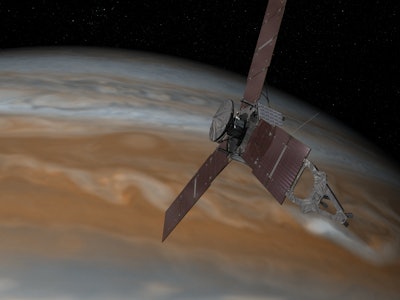At 8:51 this morning Eastern time, NASA’s Juno probe flew within 2,600 miles of Jupiter’s upper atmosphere. That’s the closest any spacecraft has ever orbited the solar system’s largest planet. The probe didn’t exactly have long to hang around taking in this unprecedented view. Juno flew over the gas giant’s swirling clouds at 130,000 miles per hour, a speed necessary to maintain escape velocity from the planet’s huge gravitational pull. For more, check out our story yesterday on the final preparations for the flyby.
NASA expects to receive the first data from this flyby within the next few days, though it will be a while yet before these first results are properly interpreted and ready for release. But for those who just want to see the first awe-inspiring close-ups of Jupiter, the wait will be much shorter. The probe’s JunoCam imager was snapping photos of Jupiter’s atmosphere and polar regions throughout the flyby, and those images are expected to be shared with the world late next week.
While 2,600 miles is now the closest any spacecraft has come to Jupiter and lived to tell about it, previous NASA craft have come even closer on one-way trips. The Galileo mission dropped a probe into the gas giant’s atmosphere when it first reached the planet in 1995, and the probe operated for nearly an hour before Jupiter’s enormous pressure crushed it. The Galileo craft itself joined the probe eight years later at the conclusion of its mission, as NASA crashed the probe into Jupiter so as to avoid potentially contaminating the moon Europa. The same fate awaits Juno at the conclusion of its mission in 2018.
